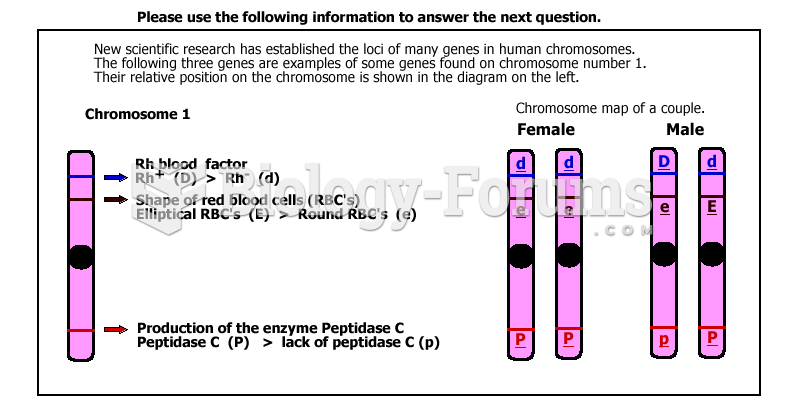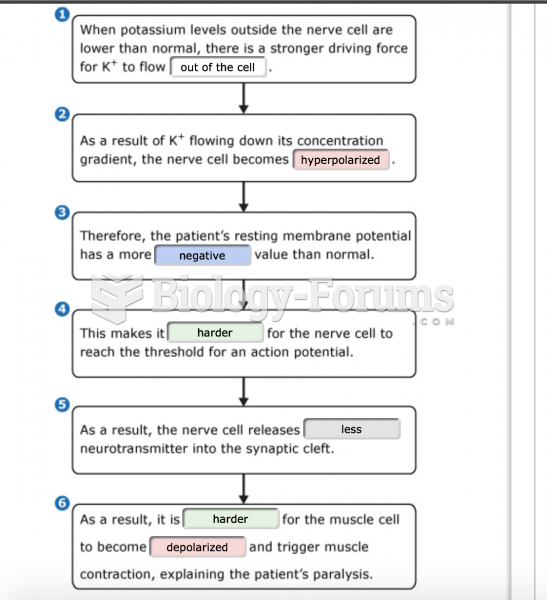Question 1:
Select the main ideas expressed in Darwin's publication On the Origin of Species?
A) Plants and animals produce more offspring than will be able to survive.
B) Present forms of life have arisen by decent and modification from an ancestral species.
C) Organisms arise spontaneously and then become increasingly more complex
D) Some species disappeared and new ones appeared over time, and that some have become extinct
E) The mechanism for modification is natural selection working for long periods of time.
F) The mechanism for modification is natural selection working for short periods of time.
Question 2:
If all organisms originated in their present forms during a single event, Darwin wondered, why was there a distinctive clustering of similar organisms in different regions of the world? Why were all types of organism not randomly distributed?
A) Darwin concluded that there was a force or forces at work in the regions that modified how the native organisms developed.
B) Darwin concluded that there was many types of species which lead to the real reason they were developed.
C) Darwin concluded that there had to be some level of the creation theory involved.
D) Darwin concluded that there was random mutation which modified how the native organisms developed.
Question 3:
How would Darwin answer: Why would living and fossilized organisms that looked similar be found within the same region?
A. Catastrophism
B. Uniformitarianism
C. Present forms of life have arisen by decent and modification from an ancestral species.
D. Paleontology
Question 4:
According to Darwin: Why did the Galapagos species so clossely resemble organisms on the adjacent South American coastline?
A. Species found on the Galapagos had been transfered by human means and the local organisms on the islands had been influenced by local conditions over time.
B. Species found on the Galapagos had been influenced by random mutation which transferred to the island which in turn can be explained by the survival of the fittest.
C. Species found on the Galapagos had originated from that area and the local organisms on the islands had influenced local conditions over time to cause change.
D. Species found on the Galapagos had somehow come from that area and the local organisms on the islands had been influenced by local conditions over time.
Question 5:
How did Darwin answer: Why was there such a diversity of species in such a small area? Could these species have been modified from an ancestral form that arrived on the Galapagos shortly after the islands were formed?
A. Darwin concluded that where there was a diversity of niches in a small isolated area, competition for habitats may have selected for commonality in the survivors and their decendants.
B. Darwin concluded that where there was not a diversity of species in a small isolated area, competition for limited resources could not have selected for variations in the survivors and their decendants.
C. Darwin concluded that where there was a scarcity of species in a small isolated area, competition for abundant resources may have selected for variations in the survivors and their decendants.
D. Darwin concluded that where there was a diversity of species in a small isolated area, competition for limited resources may have selected for variations in the survivors and their decendants.
Question 6:
According to Darwin: Could a process similar to artifical selction also operate in nature?
A. Darwin concluded that the competition for scarce resources could have the same selective effect on population as those selective decisions made by the theory of catastrphism. Becasue the forces were natural rather than instigated God, Darwin referred to the process as "natural selection."
B. Darwin concluded that the competition for scarce resources could have the same selective effect on population as those selective decisions made by breeders using artifical selection. Becasue the forces were natural rather than instigated by human, Darwin referred to the process as "natural selection."
C. Darwin concluded that abundant resources could have the same effect on population as those decisions made by breeders using artifical selection. Becasue the forces were unnatural and instigated by human, Darwin referred to the process as "unnatural selection."
D. Darwin concluded that abundant resources could have the same effect on population as those decisions made organisms in their natural habitats. Becasue the forces were natural rather than celestial, Darwin referred to the process as "natural selection."
Question 7:
Which of the following theories gives the best explanation of the pace of evolution?
A. Punctuated Equilibrium
B. Either Graduated or Punctuated Equilibrium, it depends on your view.
C. Graduated Equilibrium
D. Neither Graduated or Punctuated Equilibrium
Question 8:
Select all statements that describes the ideas of graduated equilibrium.
A. Not supported by the fossil record but should be noted that not all species leave a fossil record
B. There are periods of rapid change (i.e., rapid speciation after mass extinctions).
C. Long periods of equilibrium interupted by periods of speciation
D. After undergoing morphological changes, the species changes relatively little even as they evolve into a new species.
E. Most species undergo most of their morphological changes when they first diverge from the parent species.
F. Changes occur slowly and in a linear fashion.
G. Big changes (such as the evolution of a new species) occur as aresult of many small changes.
Question 9:
Select all statements that describes the ideas of punctuated equilibrium.
A. Most species undergo most of their morphological changes when they first diverge from the parent species.
B. There are periods of rapid change (i.e., rapid speciation after mass extinctions).
C. After undergoing morphological changes, the species changes relatively little even as they evolve into a new species.
D. Long periods of equilibrium interupted by periods of speciation
E. Not supported by the fossil record but should be noted that not all species leave a fossil record
F. Big changes (such as the evolution of a new species) occur as aresult of many small changes.
G. Changes occur slowly and in a linear fashion.
Question 10:
A women spends much of her time by swimming pools and, as aresult has very tanned skin. What would the hypothesis of inheritance of acquired characteristics say about the skin of her children?
A. It would be a slow process and might take several generations before a change could be seen in the woman's offspring.
B. Because the woman's ability to develop dark-tanned skin served a favourable purpose (adaptation) it would be passed onto her offspring.
C. Because the woman's ability to develop dark-tanned skin doesn't really serve a favourable purpose it would most likely not be passed onto her offspring.
D. There would be no change in the offspring
Question 11:
Charles Darwin surmised that species cold change over time after looking at the tortoises and the finches on the Galapagos Islands.
True or false?
Question 12:
When Charles Darwin discovered that the finches had different beaks which allowed them to eat different food and that the finches whose beaks were different lengths were not interbreeding, he surmised that these were different species.
True or false?
Question 13:
Charles Darwin's observations were also supported by his knowledge of the breeding of dogs, pigeons, and flowers. His research here showed that variations are not usually passed on through sexual reproduction and that change happened thrugh random mutation. This helped emphasize that change could happen within a species over time.
True or false?
Question 14:
Lamarck suggested that organisms arise spontaneously and then become increasingly more complex. Why is this idea not supported by the theory of natural selection ?
A) For the theory of natural selection to work it needs to be coupled with the theory that organisms arise spontaneously and then become increasingly more complex. Because without that theory the evolution of humans can not be explained.
B) Natural selection implies that species are becoming more and more complex, through survival. Which is explained through random mutation. This was demonstrated by the finches on the Galapagos Islands.
C) Natural selection does not imply that species are becoming more and more complex. (Complexity is not the goal; survival and reproduction are.) If this was the case, “simple” bacteria would be long extinct. It is not assumed that each generation is improving; populations change because of selective pressures from the environment.
D) Natural selection implies that species are becoming more and more complex. This is why some “simple” bacteria are extinct. It is assumed that each generation is improving.
Question 15:
Match the scientist with the idea.
A) Is credited with helping to develop the science of paleontology, which is the study of ancient life through the examination of fossils. He determined that different fossils are found in each layer of rock or soil and concluded that some species disappeared and new ones appeared over time, and that some have become extinct. His observations were supported by his idea of natural disaster events, which he called “revolutions”—violent shifts in the environment that caused numerous species to become extinct.
B) He wrote “Essay on the Principle of Population,” in which he explained that plants and animals of the world produce more offspring than will be able to survive. His essay was integral in helping both Wallace and me support and develop our theories. Limited amounts are known as selective pressures
C) Outlined a theory almost identical to Charles Darwin
D) He rejected catastrophism and developed the theory of uniformitarianism, which stated that geological processes operate at the same rate in the past as they do today.
E) Inheritance of aquired characteristics
Scientist #1: Thomas Malthus
Scientist #2: Charles Lyell
Scientist #3: Alfred Wallace
Scientist #4: Jean-Baptsiste Lamarck
Scientist #5: Georges Cuvier
Question 16:
Match Darwin's and Lamarck theories of evolution.
A) Organisms change through natural selection, they are always changing
B) Organisms strive toward complexity and perfection
C) Weak organisms are killed off through natural selection
D) Traits of organisms are slightly altered from generation to generation
E) Survival of the fittest does include progressive development.
F) Survival of the fittest does not include progressive development
1. Darwin
2. Lamarck
3. Both Darwin and Lamarck
Question 17:
How would Lamarck and Darwin might account for the origin of the Flying fish's large pectoral fins and the ability of the fish to glide. Match teh correct statements to whom might have made the statement.
1. Larmarck
2. Darwin
A) Flying fish arose from a simpler fish
B) Variation in fin size occurs in the population of fish
C) Those fish with the larger fins reproduced, and the advantageous trait was passed on to offspring
D) Since the fin was used over and over, the fin got larger and larger, and the modifications were passed on to the next generations of offspring
E) Over time developed a large pectoral fin because they needed it to outrun predators or hunt for insects above the water
F) At some point, the fish with the larger fins were able to survive, while fish with small fins did not.







